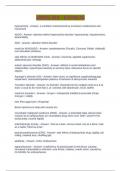UNRS 310 - EXAM #2
hyperactivity - Answer- a condition characterized by excessive restlessness and
movement
ADHD - Answer- attention deficit hyperactivity disorder; hyperactivity, impulsiveness,
distractibility
ADD - Answer- attention deficit disorder
meds for ADHD/ADD - Answer- amphetamines (Focalin, Concerta, Ritalin, Adderall)
non-stimulants (Stritera)
side effects of ADHD/ADD meds - Answer- insomnia, appetite suppression,
abdominal pain, lethargy
autism specrum disorder (ASD) - Answer- deficits in social relatedness and
relationships, hyper/hypo-reactivity to sensory input, obsessive focus on specific
objects
Asperger's disorder (AD) - Answer- later onset, no significant cognitive/language
impairment; restricted/repetitive patterns of behavior & idiosyncratic interests
Tourette's disorder - Answer- tic disorder; characterized by multiple motor tics & at
least 1 vocal tic for more than 1 yr; coexists with depression, OCD, ADHD
meds for tourette's - Answer- 1st gen = haloperidol (Haldol) & pimozide (Orap)
2nd gen = Abilify
Non-FDA approved = Risperdal
Botox injections to help with muscle tics
neuroleptic malignant syndrome (NMS) - Answer- a potentially fatal, idiosyncratic
reaction to an antipsychotic (or neuroleptic) drug; fever over 103F, severe HTN,
tachycardia, muscle rigidity
anticholinergic toxicity - Answer- "Hot as a hare, red as a beet, dry as a bone, mad
as a hatter, blind as a bat."
pseudo-parkinsonism (EPS) - Answer- side effect of antipsychotic drug, rigidity, pill
rolling, masked face, shuffling gait
akathisia - Answer- motor restlessness
agranulocytosis - Answer- a deficiency of granulocytes in the blood, causing
increased vulnerability to infection; sore throat, malaise, mouth sores; caused by
CLOZARIL for schizophrenia
, tardive dyskinesia (TD) - Answer- a late-onset, irreversible neurologic side effect of
ANTIPSYCHOTIC medications; characterized by abnormal, involuntary movements
such as lip smacking, tongue protrusion, chewing, blinking, grimacing, and
choreiform movements of the limbs and feet
schizoaffective disorder - Answer- an uninterrupted period of illness during which
there is a major depressive, manic, or mixed episode, concurrent with symptoms that
meet criteria for schizophrenia
psychoanalytic therapy - Answer- Uses various methods to help a patient become
aware of his/her unconscious motives, in order to help the patient be more able to
choose behaviors consciously. Therapy sessions usually focus on patients talking
about their lives and reducing anxiety through self insight through analysis and
interpretation.
desensitization therapy - Answer- repeated exposure to stimulus which gradually
reduces intense reaction
cognitive behavioral therapy (CBT) - Answer- a popular integrative therapy that
combines cognitive therapy (changing self-defeating thinking) with behavior therapy
(changing behavior)
dysthymia - Answer- a form of depression that is not severe enough to be diagnosed
as major depression; persistent mild depression
anhedonia - Answer- inability to feel pleasure
euphoria - Answer- feeling of extreme happiness
anergia - Answer- lack of energy
dystonia - Answer- abnormal muscle tone; ANTIPSYCHOTICS cause dystonic
reaction (muscle contractions in face/neck)
affect - Answer- appearance of observable emotions
mood - Answer- a temporary state of mind or feeling
bipolar I - Answer- most severe; more common in males; at least 1 week-long manic
episode
euphoric mania - Answer- feels wonderful in the beginning, but it turns scary and
dark as it progresses toward loss of control and confusion
dysphoric mania - Answer- mixed state or agitated depression, with depressive
symptoms along with mania
bipolar II - Answer- more common in females; at least 1 hypomanic episode, at least
1 major depressive episode




